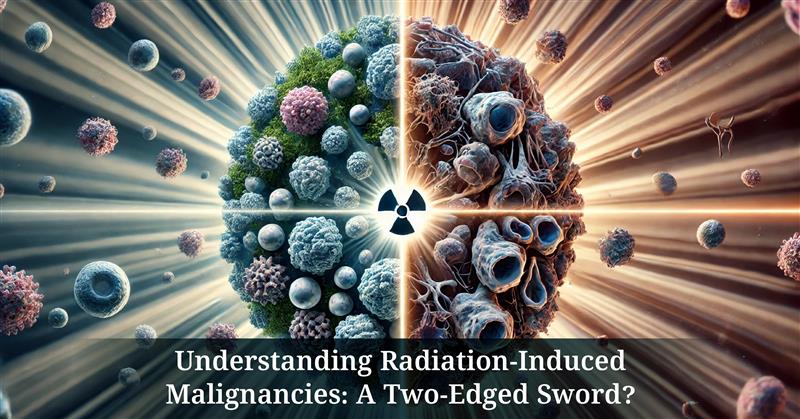Radiotherapy has long been established as one of the most useful mechanisms in handling cases of cancer. This treatment modality aims at delivering high-energy radiation to malignant cells in a bid to kill or at least impair them to stop their proliferation and formation of tumors. Nevertheless, it has been observed that radiotherapy is a popular approach whose effectiveness cannot be undermined as it is used to treat many types of cancer. but some risks come with its use. Among these, there is a group of dangers that may be truly life-threatening and need immediate treatment or follow-up care; the worst of these difficulties is radiation-induced malignancy and RIMs. By being brought about by the cancer therapy that seeks to heal or contain the primary disease, these secondary cancers are bittersweet for cancer therapy. In reality, radiotherapy is still a life-saving treatment that comes with the risk of secondary malignancies, thus adding to challenges in the long-term management of cancer survivors. This article focuses on elucidating the topic of secondary cancer development, modifiable and non-modifiable risk factors associated with radiation malignancies, and efforts being made to reduce the risk of modern-day cancer therapy.
The Dual Nature of Radiotherapy
Radiotherapy, on the other hand, makes use of ionizing radiation to affect cancer cells and damage their DNA strands. This makes it most useful against rapidly proliferating tissues or cells because, in their case, cancerous cells are usually much more sensitive to radiation than normal cells. However, this mechanism is not without risk, which can be seen in the next paragraph. Unfortunately, radiotherapy is directed at killing cancerous tissues, and this means that healthy neighboring tissues are also destroyed. The long-term effect of ionizing on healthy cells is that over time they get mutated to become malignant, thus causing secondary cancers.
An example of this is the so-called ‘radiation-induced malignancy’ which presents its own set of problems. With discoveries in handling cancer, patients are living longer only to be threatened by other cancer diseases that are a result of radiation exposure. It has been found that the risk of developing another malignancy is highest in patients who had radiotherapy for prostate, breast, and lymphatic system cancers and more, among other types of cancer. Such duality of radiotherapy, which on the one hand acts as a lawful treatment for cancer and, on the other hand, may lead to secondary malignancies, makes its clinical application highly questionable.
Mechanisms Behind Radiation-Induced Malignancies
The ways through which radiation triggers the development of secondary cancers are explained by the DNA injury that radiotherapy has on the malignant as well as nonmalignant cells. Ionizing radiation causes the breaking of the DNA strands within cells, and this is followed by the formation of mutations that will either end up killing the damaged cell or, in the worst case, transform it into a cancerous cell. Radiation is capable of inducing changes in DNA replication, chromosomal alterations, and mutations or alterations in gene expression. Although the human body has its natural ways of fixing this problem; at times, the repair is only partial and imprecise, and what you are left with are mutated cells that may turn into malignant tumors in the long run.
Similar to other malignancies, the appearance of radiation-induced malignancies depends on such factors as the doses of radiation, irradiated tissues’ volume, and the age and genetic profile of the patient. Radiation dose per fraction is inversely propositioned with lateral voltage in that raising the dose per fraction boosts the chances of cellular injury, and exposure of a bigger volume of tissue to radiation raises the number of cells in jeopardy. Further, the cancers are more likely to be induced in children, those with divided cells that are dividing rapidly, and more so given the fact that they have a longer life length so as the secondary cancers to develop.
